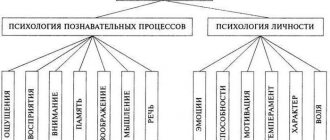Erikson proposes periodization in the form of a table. What table is this?
- Period designation;
- Designation of the social group that puts forward development tasks and in which a person improves (or you can also see a variant of the formulation “radius of significant relationships”);
- The task of development or that psychosocial crisis in which a person faces a choice;
- As a result of going through this crisis, he acquires either strong personality traits or, accordingly, weak ones. Note that as a psychotherapist, Erickson can never be judgmental. He never talks about human qualities in the format of good and bad.
Personal qualities cannot be good or bad. But he calls strong qualities those that help a person solve development problems. He will call weak those who interfere. If a person has acquired weak personality traits, it is more difficult for him to make the next choice. But he never says that this is impossible. It's just more difficult.
Traits acquired through conflict resolution are called virtues (“virtues”).
The names of the virtues in order of their gradual acquisition are: hope, will, purpose, confidence, loyalty, love, caring and wisdom.
Although Erikson tied his theory to chronological age, each stage depends not only on age-related changes in a person, but also on social factors: studying at school and college, having children, retirement, etc.
| № | Stage | Age | A crisis | Strength |
| 1 | Oral-sensory (infancy) | up to 1 year | Basal trust – basal distrust | Hope |
| 2 | Musculo-anal (early childhood) | 1-3 years | Autonomy – shame and doubt | Strength of will |
| 3 | Locomotor-genital (preschool age) | 3-6 years | Initiative - guilt | Target |
| 4 | Latent (school age) | 6-12 years | Hard work is inferiority | Competence |
| 5 | Adolescence (youth) | 12-20 years | Ego identity - role confusion | Loyalty |
| 6 | Early adulthood (youth) | 20-25 years | Intimacy - isolation | Love |
| 7 | Middle maturity (maturity) | 26-64 years | Productivity is stagnant | Care |
| 8 | Late maturity (old age) | 60-65 – death | Ego integration - despair | Wisdom |
Definition and essence
Age periodization according to Erikson is the stages of formation that a person goes through from birth to death. The psychoanalyst identified 8 stages, expanding the classical theory of psychoanalysis.
The development process lasts continuously throughout life, each stage replaces the previous one with the successful or unsuccessful overcoming of specific crisis moments.
With a favorable passage, qualities such as will, hope, confidence, determination, loyalty, care, love, and wisdom develop.
Erikson emphasized “Ego-identity”; the integrity of personal development is achieved despite the influence of external factors and society.
Periodization helps to answer the question “Who am I?”, to find a balance between the individual psyche and the roles imposed by society.
The theory of personality development is interesting not only from the point of view of psychoanalysis. Instructive for parents facing childhood crises, teachers shaping the future generation, businessmen creating a productive team, and the individual himself learning about his own self. The concept provides some pedagogical solutions for successfully overcoming specific crises.
The development process can take place passively or actively with the participation of a person’s original initiatives. Age periodization describes the passive, natural development of a healthy personality, marking the peaks of successfully passed crises.
It is used for psychoanalysis when mental disorders occur due to external circumstances or when acquiring negative experience at a certain stage. The concept indicates the connection between specific crises and age stages, and notes adaptive, successful paths of development.
Erikson's theory, developed in the last century, became the basis for the further development of psychoanalysis. Research into the development of personality stages was continued by followers of classical psychoanalysis. Thus, James Marcia continued to develop identity statuses at the stage of adolescence.
American psychologist John Hill examined in his works the deep processes of mental development of personality. Research by J. Côté and C. Levine on psychoanalytic social psychology is based on age periodization.
Erikson's concept was criticized mainly by representatives of nativism, who believe that the characteristics of a mature personality are predetermined from the moment of conception. The main driving force in the formation of the psyche is called heredity, minimizing the role of the influence of the environment, culture, and society.
Infancy
From birth to one year is the first stage in which the foundations of a healthy personality are laid in the form of a general sense of trust.
The main condition for developing a sense of trust in people is the mother’s ability to organize the life of her small child in such a way that he has a sense of consistency, continuity and recognition of experiences.
An infant with an established sense of basic trust perceives his environment as reliable and predictable. He can bear the absence of his mother without undue distress and anxiety about being “separation” from her. The main ritual is mutual recognition, which persists throughout subsequent life and permeates all relationships with other people.
The methods of teaching trust or suspicion in different cultures do not coincide, but the principle itself is universal: a person trusts the world around him, based on the degree of trust in his mother. A feeling of mistrust, fear and suspicion appears if the mother is unreliable, incompetent, or rejects the child.
Mistrust can intensify if the child ceases to be the center of her life for the mother, when she returns to previously abandoned activities (resumes an interrupted career or gives birth to another child).
Hope as optimism regarding one’s cultural space is the first positive quality of the ego acquired as a result of successful resolution of the trust/distrust conflict.
Early childhood
The second stage lasts from one to three years and corresponds to the anal phase in the theory of Sigmund Freud. Biological maturation creates the basis for the emergence of independent actions of the child in a number of areas (moving, washing, dressing, eating). From Erikson’s point of view, the child’s clash with the demands and norms of society occurs far beyond just potty training. Parents should gradually expand the opportunities for independent action and self-control in children.
Reasonable permission contributes to the development of child autonomy.
In the case of constant excessive care or inflated expectations, he experiences shame, doubt and self-doubt, humiliation, and weakness of will.
An important mechanism at this stage is critical ritualization, based on specific examples of good and evil, good and bad, permitted and prohibited, beautiful and ugly. The child’s identity at this stage can be indicated by the formula: “I myself” and “I am what I can.”
If the conflict is successfully resolved, the Ego includes will and self-control, and if the outcome is negative, it includes weakness of will.
Criteria and principles
Erik Erikson became a follower of Sigmund Freud, expanding his theory of psychosexual development. According to Z. Freud, man is a biological being, guided by the instincts of life and death. Behavior is controlled by libido, which finds release in sexual behavior. E. Erikson expanded the concept of personality development and looked at it through the prism of the influence of society.
According to his concept, the values and norms of society are transmitted through the process of education. Formation occurs under the influence of society, which imposes certain roles, values, and ideals.
At each stage, a person goes through certain stages, depending on biological age. Gradually, step by step, the process of identity occurs, it is possible to define oneself as an integral person in society.
Basic principles:
- Society is the main environment for personality formation.
- Development occurs continuously from birth to death.
- The process of formation goes through successive stages.
- The stages of life are identical for everyone.
- The transition from stage to stage is accompanied by a personal crisis; a person may or may not successfully overcome the stage.
- The crisis is accompanied by a loss of identity; the task of psychoanalysis is its restoration.
Erikson believed that primary motivation is social, not personal.
The concept is based on the following theses:
- Individual Differences - Each person has a different ego strength.
- The unconscious participates in cognitive processes, manifesting itself through symbols and games.
- Society determines the path of human development.
- Gender differences are due to the biological characteristics of men and women. Sexual specificity of development depends on the strength of libido.
- Epigenetics - the growth and development of a person follows a certain plan, according to which parts arise that dominate a certain period. The main task of each stage is to form a functional whole (healthy ego).
Playing age, preschool age
The third period is the “age of play,” from 3 to 6 years. Children begin to become interested in various work activities, try new things, and communicate with peers. At this time, the social world requires the child to be active, solve new problems and acquire new skills; he has additional responsibility for himself, for younger children and pets. This is the age when the main sense of identity becomes “I am what I will be.”
A dramatic (game) component of the ritual develops, with the help of which the child recreates, corrects and learns to anticipate events.
Initiative is associated with the qualities of activity, enterprise and the desire to “attack” a task, experiencing the joy of independent movement and action. The child easily identifies himself with significant people, readily lends himself to training and education, focusing on a specific goal.
At this stage, as a result of the acceptance of social norms and prohibitions, the Super-Ego is formed, and a new form of self-restraint arises.
Parents, encouraging the child’s energetic and independent endeavors, recognizing his rights to curiosity and imagination, contribute to the development of initiative, expanding the boundaries of independence, and the development of creative abilities.
Close adults who severely limit freedom of choice, overly control and punish children cause them to feel too much guilt.
Children overcome by feelings of guilt are passive, constrained and have little capacity for productive work in the future.
Age stages of personality development (according to E. Erikson).
American psychologist E. Erikson (1902-1994) is known as a representative of the direction of ego psychology.
He identified 8 psychosocial stages of personality development:
1. Infancy : basal trust / basal distrust . The first psychosocial stage - from birth to the end of the first year - corresponds to the oral stage, according to Freud. During this period, the foundations of a healthy personality are laid in the form of a general sense of trust, “confidence,” and “internal certainty.” Erikson considers the main condition for developing a sense of trust in people to be the quality of maternal care - the ability of a mother to organize the life of her small child in such a way that he has a feeling of consistency, continuity, and recognition of experiences.
An infant with an established sense of basic trust perceives his environment as reliable and predictable; he can bear his mother's absence without undue distress and anxiety about being "separation" from her. A feeling of mistrust, fear, suspicion appears if the mother is unreliable, insolvent, rejects the child; it can intensify when the child ceases to be the center of her life for the mother, when she returns to those activities that she left for a while (resumes an interrupted career or gives birth to another child). The methods of teaching trust or suspicion in different cultures do not coincide, but the principle itself is universal: a person trusts society based on the degree of trust in his mother.
Erikson shows the enormous importance of the mechanism of ritualization already in infancy. The main ritual is mutual recognition, which persists throughout subsequent life and permeates all relationships with other people.
2. Early childhood: autonomy/shame and doubt . This period lasts from one to three years and corresponds to the anal stage, according to Freud. Biological maturation creates the basis for the emergence of new opportunities for independent action of the child in a number of areas (for example, standing, walking, climbing, washing, dressing, eating). From Erikson’s point of view, the child’s collision with the demands and norms of society occurs not only when the child is potty trained; parents must gradually expand the possibilities of independent action and self-control in children. The child’s identity at this stage can be indicated by the formula: “I myself” and “I am what I can.”
Reasonable permission contributes to the development of child autonomy. In the case of constant excessive care or, on the contrary, when parents expect too much from a child, something that lies beyond his capabilities, he experiences shame, doubt and self-doubt, humiliation, and weakness of will.
Thus, with a successful resolution of the conflict, the Ego includes will, self-control, and with a negative outcome, weakness of will. An important mechanism at this stage is critical ritualization, based on specific examples of good and evil, good and bad, permitted and prohibited, beautiful and ugly.
3. Age of play: initiative / guilt . In the preschool period, which Erikson called the “age of play,” from 3 to 6 years, a conflict unfolds between initiative and guilt. Children begin to become interested in various work activities, try new things, and communicate with peers. At this time, the social world requires the child to be active, solve new problems and acquire new skills; he has additional responsibility for himself, for younger children and pets. This is the age when the main sense of identity becomes “I am what I will be.”
A dramatic (game) component of the ritual develops, with the help of which the child recreates, corrects and learns to anticipate events. Initiative is associated with the qualities of activity, enterprise and the desire to “attack” a task, experiencing the joy of independent movement and action. At this stage, the child easily identifies himself with significant people (not only parents), and readily lends himself to training and education, focusing on a specific goal. At this stage, as a result of the adoption of social prohibitions, the Super-Ego is formed, and a new form of self-restraint arises.
Parents, encouraging the child’s energetic and independent endeavors, recognizing his rights to curiosity and imagination, contribute to the development of initiative, expanding the boundaries of independence, and the development of creative abilities. Close adults who severely limit freedom of choice, overly control and punish children cause them to feel too much guilt. Children overcome by feelings of guilt are passive, constrained and have little capacity for productive work in the future.
4. School age: hard work/inferiority . The fourth psychosocial period corresponds to the latent period in Freud's theory. Rivalry with the parent of the same sex has already been overcome. At the age of 6 to 12 years, the child leaves the family and begins systematic learning, including familiarization with the technological side of culture. What is universal in Erikson’s concept is precisely the desire and receptivity to learning something that is significant within a given culture (the ability to handle tools, weapons, crafts, literacy and scientific knowledge).
The term “hard work”, “taste for work” reflects the main theme of this period; children at this time are absorbed in the fact that they strive to find out what comes out of what and how it works. The child's ego identity is now expressed as: “I am what I have learned.”
While studying at school, children are introduced to the rules of conscious discipline and active participation. The ritual associated with school routines is perfection of execution. The danger of this period is the emergence of feelings of inferiority, or incompetence, doubts about one’s abilities or status among peers.
5. Youth: ego - identity / role confusion. Adolescence, the fifth stage in Erikson's life cycle diagram, is considered the most important period in human psychosocial development: “Adolescence is the age of final establishment of the dominant positive ego identity. It is then that the future, within the foreseeable limits, becomes part of the conscious plan of life.” Erikson paid great attention to adolescence and adolescence, considering it central in the formation of a person’s psychological and social well-being. No longer a child, but not yet an adult (from 12-13 years old to about 19-20 in American society), the teenager is faced with new social roles and the demands associated with them. Teenagers evaluate the world and their attitude towards it. They think and can come up with an ideal family, religion, philosophical system, social structure.
There is a spontaneous search for new answers to important questions: “Who am I? ", "Where am I going? ", "Whom I want to become? " The teenager’s task is to put together all the knowledge about themselves available by this time (what kind of sons or daughters they are, students, athletes, musicians, etc.) and create a single image of themselves (ego identity), including awareness of how the past and the expected future. The perception of oneself as a young person must be confirmed by the experience of interpersonal communication.
Adolescents experience a piercing sense of their uselessness, mental discord and aimlessness, sometimes rushing towards a “negative” identity and delinquent (deviant) behavior. In the case of a negative resolution of the crisis, “role confusion” occurs, a vagueness of the individual’s identity. An identity crisis, or role confusion, leads to an inability to choose a career or continue education, sometimes to doubts about one's own gender identity.
The reason for this may also be excessive identification with popular heroes (movie stars, super athletes, rock musicians) or representatives of the counterculture (revolutionary leaders, “skinheads”, delinquent individuals), tearing out the “blooming identity” from its social environment, thereby suppressing and limiting it .
A positive quality associated with a successful recovery from the crisis of adolescence is fidelity, i.e. the ability to make your choice, find your path in life and remain faithful to your obligations, accept social principles and adhere to them.
6. Youth: Achieving Intimacy/Isolation.
The sixth psychosocial stage extends from late adolescence to early adulthood (20 to 25 years), marking the formal beginning of adulthood. In general, this is the period of obtaining a profession (“establishment”), courtship, early marriage, and the beginning of an independent family life.
Erikson uses the term intimacy (achieving closeness) as multifaceted, but the main thing is maintaining reciprocity in relationships, merging with the identity of another person without fear of losing oneself. It is this aspect of intimacy that Erikson views as a necessary condition for a lasting marriage.
The main danger at this psychosocial stage is excessive self-absorption or avoidance of interpersonal relationships. The inability to establish calm and trusting personal relationships leads to feelings of loneliness, social vacuum and isolation.
The positive quality that is associated with a normal way out of the intimacy/isolation crisis is love. Erickson emphasizes the importance of the romantic, erotic, and sexual components, but views true love and intimacy more broadly - as the ability to entrust oneself to another person and remain faithful to this relationship, even if they require concessions or self-denial, the willingness to share all difficulties with him. This type of love manifests itself in a relationship of mutual care, respect and responsibility for the other person.
7. Maturity: productivity / inertia . The seventh stage occurs in the middle years of life (from 26 to 64 years); its main problem is the choice between productivity and inertia. Productivity appears as the concern of the older generation about those who will replace them - about how to help them gain a foothold in life and choose the right direction. A good example in this case is a person’s sense of self-realization associated with the achievements of his descendants.
If in adults the ability for productive activity is so pronounced that it prevails over inertia, then the positive quality of this stage manifests itself - care.
Those adults who fail to become productive gradually move into a state of self-absorption, where the main concern is their own personal needs and comforts. These people do not care about anyone or anything, they only indulge their desires. With the loss of productivity, the functioning of the individual as an active member of society ceases, life turns into satisfying one’s own needs, and interpersonal relationships become impoverished. This phenomenon—the “senior age crisis”—is expressed in a feeling of hopelessness and meaninglessness of life.
13. Old age: ego integrity/despair.
The last psychosocial stage (from 65 years to death) ends a person's life. In almost all cultures, this period marks the beginning of old age, when a person is overcome by numerous needs: having to adapt to the fact that physical strength and health are deteriorating, getting used to a more modest financial situation and a solitary lifestyle, adapting to the death of a spouse and close friends, as well as to establish relationships with people of your own age. At this time, the focus of a person’s attention shifts from worries about the future to past experiences, people look back and reconsider their life decisions, remember their achievements and failures. Erickson was interested in this internal struggle, this internal process of rethinking his own life.
According to Erikson, this last phase of life is characterized not so much by a new psychosocial crisis as by the summation, integration and evaluation of all past stages of ego development: “Only for those who in some way cared about affairs and people, who experienced triumphs and defeats in life, who inspired others and put forward ideas - only he can gradually ripen the fruits of the seven previous stages. I don't know a better word for this than ego integration.
The sense of ego integration is based on a person's ability to look back at his entire past life (including marriage, children and grandchildren, career, achievements, social relationships) and humbly but firmly say to himself, “I am content.” The inevitability of death is no longer frightening, since such people see the continuation of themselves either in descendants or in creative achievements. Erikson believes that only in old age does true maturity and a useful sense of “the wisdom of past years” come. But at the same time he is about
At the opposite pole are people who view their lives as a series of unrealized opportunities and mistakes. Now, at the end of their lives, they realize that it is too late to start over or look for some new ways to feel the integrity of their Self. The lack or absence of integration manifests itself in these people in a hidden fear of death, a feeling of constant failure and concern about what can happen". Erikson identifies two predominant types of mood in irritable and indignant older people: regret that life cannot be lived again, and denial of one's own shortcomings and defects by projecting them onto the outside world.
School age
The fourth period corresponds to the ages of 6 to 12 years and is chronologically similar to the latent period in Freud's theory. Rivalry with a parent of the same sex has already been overcome, the child leaves the family and becomes familiar with the technological side of culture.
At this time, the child gets used to systematic learning, learns to win recognition by doing useful and necessary things.
The term “hard work”, “taste for work” reflects the main theme of this period; children at this time are absorbed in the fact that they strive to find out what comes out of what and how it works. The child's ego identity is now expressed as: “I am what I have learned.” While studying at school, children are introduced to the rules of conscious discipline and active participation. School helps the child develop a sense of hard work and achievement, thereby reaffirming a sense of personal strength. The ritual associated with school routines is perfection of execution.
Having built in the early stages feelings of trust and hope, autonomy and “will power,” initiative and determination, the child must now learn everything that can prepare him for adult life.
The most important skills he must acquire are the socialization aspects: cooperation, interdependence and a healthy sense of competition.
If a child is encouraged to tinker, do handicrafts, cook, is allowed to finish what he has started, and is praised for his results, then he develops a sense of competence, “skill,” confidence that he can master a new task, and his abilities for technical creativity develop.
If parents or teachers see the child’s work as mere pampering and an obstacle to “serious studies,” then there is a danger of developing in him a feeling of inferiority and incompetence, doubts about his abilities or status among his peers. At this stage, the child may develop an inferiority complex if adults' expectations are too high or too low.
Freud and Erikson: theoretical differences
difference between the theories of Freud and Erikson
Erikson accepted the main provisions of Freud's theory. Although Freud focused on sexual factors as the driving force of psychological development, Erikson believed that social factors also played a vital role.
Unlike Freud, who argued that personality is formed by age 5, Erikson believed that a person continues to develop his personality into adolescence and even throughout adulthood.
Youth
The fifth stage in Erikson's life cycle diagram, from 12 to 20 years of age, is considered the most important period in human psychosocial development:
“Youth is the age of final establishment of a dominant positive identity.
It is then that the future within the foreseeable limits becomes part of the conscious plan of life.” This is the second major attempt to develop autonomy, and it requires challenging parental and social norms.
The teenager is faced with new social roles and associated requirements. Teenagers evaluate the world and their attitude towards it. They think about the ideal family, religion, and the social order of the world.
There is a spontaneous search for new answers to important questions: Who is he and who will he become? Is he a child or an adult? How do his ethnicity, race, and religion affect how people view him? What will be his true authenticity, his true identity as an adult?
Such questions often make the teenager painfully concerned about what others think of him and what he should think about himself. Ritualization becomes improvisational, and the ideological aspect is highlighted in it. Ideology provides young people with simplified but clear answers to major questions related to identity conflict.
The teenager’s task is to put together all the knowledge he has by this time about himself (what kind of sons or daughters they are, students, athletes, musicians, etc.) and create a single image of himself (ego identity), including awareness of how the past and the expected future.
The transition from childhood to adulthood causes both physiological and psychological changes.
Psychological changes manifest themselves as an internal struggle between the desire for independence, on the one hand, and the desire to remain dependent on those people who care about you, and the desire to be free from the responsibility of being an adult, on the other. Faced with such confusion about his status, a teenager always seeks confidence, security, trying to be like other teenagers in his age group. He develops stereotypical behavior and ideals. Peer groups are very important for restoring self-identity. The destruction of strictness in dress and behavior is inherent in this period.
The positive quality associated with successfully overcoming the crisis of adolescence is self-fidelity, the ability to make your own choice, find a path in life and remain faithful to your obligations, accept social principles and adhere to them.
Erikson considers drastic social changes and dissatisfaction with generally accepted values as a factor that interferes with the development of identity, contributing to a feeling of uncertainty and inability to choose a career or continue education. A negative way out of the crisis is expressed in poor self-identity, a feeling of uselessness, mental discord and aimlessness; sometimes teenagers rush towards delinquent behavior. Excessive identification with stereotypical heroes or representatives of the counterculture suppresses and limits the development of identity.
Meaning and role
Age periodization allows us to determine the norms of personality development and compliance with biological age. Features of successive stages are used in psychology, pedagogy, and sociology. Answers questions regarding the development of personality, culture, and society.
Application of age periodization:
- parents, knowing the features of certain stages, contribute to the formation of positive qualities in the child and help overcome specific crises;
- teachers use it to form identity when roles are confused, contribute to the successful passage of crises of previous stages;
- psychologists use tools of age periodization to form a healthy human psyche, restore the balance between individuality and social roles;
- sociologists study the influence of self-identity on the development of culture and society to reduce deviant behavior among adolescents and adults.
Erikson identified a pattern of physiological and mental development of generations, regardless of the demands of society. Age periodization allows you to develop strategies for education, training, and work. The relationship between successful personal development is also used to form a healthy society at the state level.
You can use Erikson's table to search for self-identity, successfully overcome crises, and understand your social roles. Knowing the characteristics of each age, it is easier to determine the goals and objectives of a particular period. Classification is necessary for the proper management of the dynamic development and spiritual growth of society.
Age periodization is based on the continuous development of personality, the dependence of psychological health and the successful overcoming of crisis stages. At each stage, the influence of society is felt, in turn, the individual also influences the development of society.
According to Erikson, the periodization of classical psychoanalysis expanded to cover the entire human life cycle. The created concept became the basis for the development of developmental psychology, as well as for a more detailed psychoanalysis of personality.
Youth
The sixth psychosocial stage lasts from 20 to 25 years and marks the formal beginning of adulthood. In general, this is the period of acquiring a profession, courtship, early marriage, and the beginning of an independent family life.
Intimacy (achieving closeness) - as maintaining reciprocity in a relationship, merging with the identity of another person without fear of losing oneself.
The ability to be involved in a loving relationship includes all of the previous developmental tasks:
- a person who does not trust others will find it difficult to trust himself;
- in case of doubt and uncertainty, it will be difficult to allow others to cross your boundaries;
- a person who feels inadequate will have difficulty getting close to others and taking initiative;
- a lack of hard work will lead to inertia in relationships, and a lack of understanding of one’s place in society will lead to mental discord.
The capacity for intimacy is perfected when a person is able to build intimate partnerships, even if they require significant sacrifices and compromises.
The ability to trust and love another, to derive satisfaction from mature sexual experiences, to seek compromises in common goals - all this indicates satisfactory development during the youth stage.
The positive quality that is associated with a normal way out of the “intimacy/isolation” crisis is love. Erikson emphasizes the importance of the romantic, erotic, and sexual components, but views true love and intimacy more broadly as the ability to commit oneself to another person and remain faithful to this relationship, even if it requires concessions or self-denial, the willingness to share all difficulties together. This type of love manifests itself in a relationship of mutual care, respect and responsibility for the other person.
The danger of this stage is avoidance of situations and contacts that lead to intimacy.
Avoiding the experience of intimacy for fear of “losing independence” leads to self-isolation. The inability to establish calm and trusting personal relationships leads to feelings of loneliness, social vacuum and isolation.
Question answered: Can I have intimate relationships?
Maturity
The seventh stage occurs in the middle years of life from 26 to 64 years. Its main problem is the choice between productivity (generativity) and inertia (stagnation). An important point of this stage is creative self-realization.
“Mature adulthood” brings a more consistent, less unstable sense of self.
The Self manifests itself by giving more in human relationships at home, at work and in society. There is already a profession, the children have become teenagers. The sense of responsibility for oneself, others and the world becomes deeper.
In general, this stage involves a productive work life and a nurturing parenting style. The ability to be interested in universal human values, the destinies of other people, to think about future generations and the future structure of the world and society develops.
Productivity acts as the concern of the older generation about those who will replace them, about how to help them gain a foothold in life and choose the right direction.
If in adults the ability for productive activity is so pronounced that it prevails over inertia, then the positive quality of this stage is manifested - care.
Difficulties in “productivity” may include an obsessive desire for pseudo-intimacy, over-identification with a child, a desire to protest as a way to solve stagnation, reluctance to let go of one’s own children, impoverished personal life, self-absorption.
Those adults who fail to become productive gradually move into a state of self-absorption, when the main subject of concern is their own personal needs and comforts. These people do not care about anyone or anything, they only indulge their desires. With the loss of productivity, the functioning of the individual as an active member of society ceases, life turns into satisfying one’s own needs, and interpersonal relationships become impoverished.
This phenomenon, like a midlife crisis, is expressed in a feeling of hopelessness and meaninglessness of life.
Questions answered: What does my life mean to this day? What am I going to do with the rest of my life?










